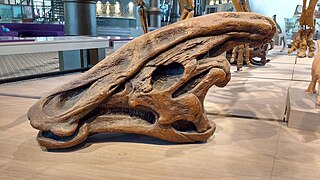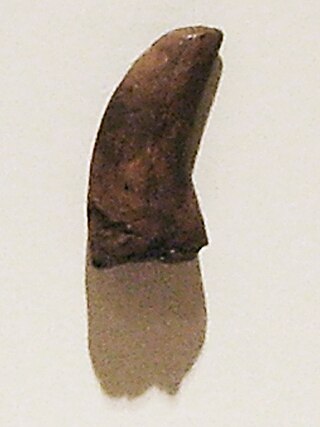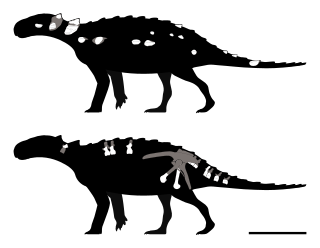Serendipaceratops is a genus of herbivorous ornithischian dinosaur, possibly an ankylosaur, from the early Cretaceous Period of Australia. The type species, S. arthurcclarkei, was named in 2003.

Charonosaurus is a genus of dinosaur whose fossils were discovered by Godefroit, Zan & Jin in 2000, on the south bank of the Amur River, dividing China from Russia. It is monotypic, consisting of the species C. jiayinensis.

Dromaeosauroides is a genus of dromaeosaurid theropod dinosaur from the Early Cretaceous of what is now Denmark and possibly also England. It was discovered in the Jydegaard Formation in the Robbedale valley, on the island of Bornholm in the Baltic Sea. This is the only likely place for dinosaur remains to be discovered on Danish territory, since the Mesozoic deposits exposed in the rest of the country are marine. Dromaeosauroides is the first known dinosaur from Denmark, and the only one which has been scientifically named. It is one of the oldest known dromaeosaurs in the world, and the first known uncontested dromaeosaur from the Early Cretaceous of Europe.

Sulcavis is a genus of enantiornithean birds. One species is named, Sulcavis geeorum. The fossil was found in Early Cretaceous rocks in Liaoning Province, China.

Diluvicursor is a genus of small ornithischian from the Lower Albian of Australia. It is known from one species, the type species D. pickeringi. The two known specimens, a vertebra and a partial juvenile postcranium discovered in 2005 from the Eumeralla Formation, are known, and they were named in early 2018.

Abdarainurus is a genus of titanosaur dinosaur from the Alagteeg Formation in Mongolia. The type and only species is A. barsboldi. Currently seen as an indeterminate titanosaur, it may represent a previously unknown lineage of Asian macronarians. Abdarainurus is not known from many remains; it is only known from eight front tail vertebrae and a middle tail vertebra and several chevrons.

Dineobellator is a genus of dromaeosaurid theropod dinosaur that lived in North America during the Late Cretaceous period 68 million years ago. The remains have been found in the Maastrichtian stage of the Naashoibito Member at the Ojo Alamo Formation, New Mexico.

Tlatolophus is a genus of hadrosaurid dinosaur belonging to the tribe Parasaurolophini. The only species is the type species, Tlatolophus galorum.

Australotitan is an extinct genus of possibly titanosaurian somphospondylan dinosaurs from the Late Cretaceous Winton Formation (Cenomanian–Turonian) of southern-central Queensland, Australia. The genus contains a single species, A. cooperensis, known from multiple partial skeletons. The genus Australotitan may be synonymous with Diamantinasaurus, a contemporary relative.

Spicomellus is an extinct genus of early ankylosaurian dinosaur from the El Mers III Formation (Bathonian-Callovian) of Morocco. The genus contains a single species, S. afer, known from a single rib with fused osteoderms. Spicomellus represents the oldest named ankylosaur.

Issi is a plateosaurid dinosaur described in 2021 from the Late Triassic Fleming Fjord Formation of Greenland. It contains one species, Issi saaneq; the full binomial name means "cold bone".

IberospinusIPA:[aɪbiːʌroʊs̠piːnʊs̠] or IPA:[aɪbiːʌroʊs̠paɪnʌs̠] is an extinct genus of spinosaurid dinosaur from the Early Cretaceous (Barremian) Papo Seco Formation of Portugal. The genus contains a single species, I. natarioi, known from several assorted bones belonging to one individual. Iberospinus represents one of five known spinosaurid taxa from the Iberian Peninsula, the others being Camarillasaurus, Protathlitis, Riojavenatrix, and Vallibonavenatrix. It is important for its implications of the geographical origin of Spinosauridae and the suggested presence of an at least semi-aquatic lifestyle early in the evolution of this clade.

Paralitherizinosaurus is an extinct genus of therizinosaurid dinosaur from the Late Cretaceous Osoushinai Formation of Hokkaido, Japan. The genus contains a single species, P. japonicus, known from a partial right hand and cervical vertebra. Paralitherizinosaurus represents the youngest therizinosaur known from Japan.

Meraxes is a genus of large carcharodontosaurid theropod dinosaur from the Late Cretaceous Huincul Formation of Patagonia, Argentina. The genus contains a single species, Meraxes gigas.
Mbiresaurus is an extinct genus of basal sauropodomorph dinosaur from the Late Triassic (Carnian) Pebbly Arkose Formation of Zimbabwe. The genus contains a single species, Mbiresaurus raathi, known from a nearly complete skeleton. Mbiresaurus represents one of Africa’s earliest known definitive dinosaurs.
Ibirania is a genus of dwarf saltasaurine titanosaur dinosaur from the Late Cretaceous São José do Rio Preto Formation of Southeast Brazil. The type species is Ibirania parva. It is one of the smallest sauropods known to date, comparable in size to the titanosaur Magyarosaurus.
Gamatavus is a genus of silesaurid dinosauriform from the Middle Triassic Santa Maria Formation of Dilermando de Aguiar Municipality, Brazil. The genus contains a single species, G. antiquus, known from a partial ilium. Gamatavus represents the oldest silesaurid known from South America.
The Willow Tank Formation is a geologic formation which outcrops in the U.S. state of Nevada. Initially believed to be of Early Cretaceous (Albian) age, later studies have concluded that it was more likely to be of Late Cretaceous (Cenomanian) age, making it equivalent to the Cloverly and Cedar Mountain Formations. It was deposited in an anastomosed fluvial system.

Patagopelta is an extinct genus of ankylosaurian dinosaur from the Late Cretaceous Allen Formation of Argentina. The genus contains a single species, P. cristata, known from a partial skeleton. While originally described as a nodosaurine, later discoveries provided support for parankylosaurian affinities for the taxon. Patagopelta is a very small ankylosaur, comparable in size to the dwarf nodosaurid Struthiosaurus, about 2 m (6.6 ft) long.



















